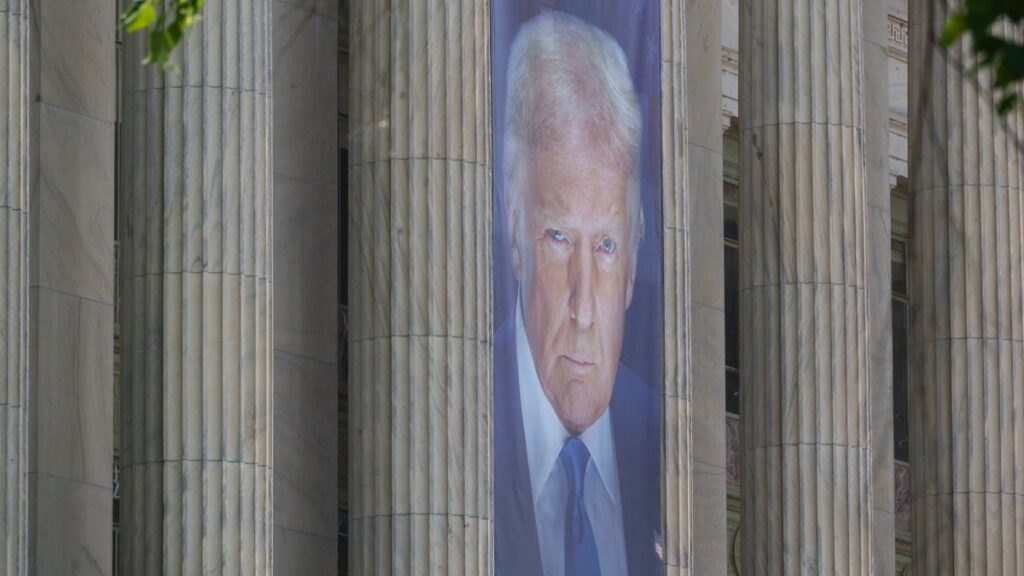Global Economic Turmoil Triggered by President Trump’s Tariff Policies
The implementation of tariffs by President Donald Trump has sent shockwaves through the global economy, creating widespread uncertainty and upheaval in international trade networks.

In Washington, D.C., a large banner featuring President Trump dominates the facade of the U.S. Department of Agriculture, symbolizing the administration’s aggressive trade stance.
UPDATE: As of April 29, 2025, 5:23 p.m. EDT – A federal appeals court has granted the White House’s request to expedite the review of a trade court’s decision that temporarily blocked President Trump’s tariffs. The Trump administration is now expected to seek “emergency relief” from the Supreme Court. For more details, see our ongoing coverage below.
Judicial Ruling Challenges the Authority of Presidential Tariffs
On Wednesday, April 28, a three-judge panel of the U.S. Court of International Trade issued a landmark decision, ruling that President Trump exceeded his constitutional authority in imposing most of his tariffs. This decision injects further unpredictability into the already volatile global economic landscape.
President Trump’s tariff policies have significantly disrupted international trade flows. His often impulsive rollout of what he termed “Liberation Day” tariffs has led to rising consumer costs, intense political debates, and complex negotiations with trading partners and adversaries alike.
Legal Foundations and Constitutional Concerns
The court scrutinized whether the International Emergency Economic Powers Act of 1977 (IEEPA) grants the president the sweeping authority to impose tariffs on virtually all imports from nearly every country. The judges concluded that this authority is not as broad as the administration claims. Notably, the ruling emphasizes that the U.S. Constitution explicitly assigns Congress the power to regulate tariffs, and this delegation cannot be permanently transferred to the executive branch.
The decision specifically invalidates several of Trump’s signature tariffs, which he justified under emergency powers. The ruling states that the IEEPA does not authorize the broad, unilateral tariff orders issued by the president, marking a significant legal setback for the administration.
This case was initiated by numerous states that have suffered financial losses due to increased import duties, which have raised costs for consumers and businesses across the country.
Implications for Future Trade Policies
The panel’s decision was composed of judges appointed by a diverse political spectrum, including a judge appointed by President Trump himself, as well as judges appointed by Ronald Reagan and Barack Obama, reflecting a broad judicial consensus.
What Are the Next Steps?
Since assuming office just over four months ago, President Trump has faced multiple judicial blocks on his executive actions. This latest ruling could effectively halt the “Liberation Day” tariffs, although the White House has 10 days to respond, according to The New York Times.
Nevertheless, the tariffs may not be entirely defunct. Congress retains the authority to establish tariffs independently, and the Trump administration plans to challenge this ruling before the Supreme Court, which has historically reversed lower court decisions that limited presidential powers.
While President Trump appointed three conservative justices to the Supreme Court, their rulings have often defied expectations, sometimes ruling against the administration’s interests. Congressional Republicans remain largely supportive of the president’s trade policies, and many would prefer to reassert tariff authority through legislative means rather than executive orders.
White House spokesperson Kush Desai stated, “It is not for unelected judges to determine how to handle a national emergency. President Trump has committed to putting America first, and his administration will utilize every available executive tool to address this crisis and restore American economic strength.”
Looking Ahead: The Future of U.S. Trade Policy
The ongoing legal battles highlight the complex interplay between executive authority and legislative oversight in shaping U.S. trade policy. As the White House prepares to appeal the recent ruling, the possibility remains that future tariffs-such as the recent threats against smartphone imports-could be enacted through congressional legislation rather than executive orders.
This legal contest underscores the broader debate over the scope of presidential powers in times of economic crisis, with implications that extend beyond tariffs to other areas of national security and economic policy.
Expert Perspectives and Broader Context
Timothy Beck Werth, Mashable’s Tech Editor, notes that the legal challenges to Trump’s tariffs reflect a broader trend of judicial checks on executive authority. With over 15 years of experience covering technology and consumer goods, Werth emphasizes that the outcome of this legal dispute could set a precedent for future presidential actions in economic policy.
As the global economy continues to navigate the repercussions of these tariffs, businesses and consumers alike await further developments. The ongoing legal battles will likely influence trade negotiations and policy decisions for years to come, shaping the future landscape of international commerce.

